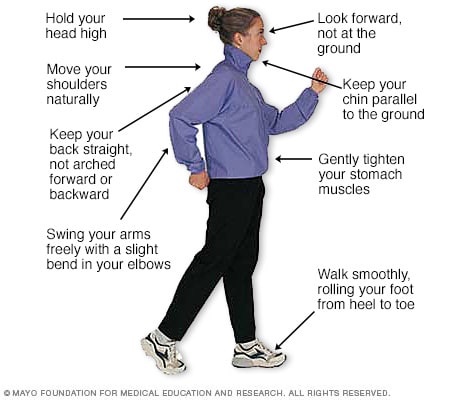Walking Vs Brisk Walking : Maximize Your Fitness Gains
Walking burns calories steadily, while brisk walking boosts heart rate and burns more calories per minute. Walking is a low-impact exercise suitable for all fitness levels, aiding in weight management and improving cardiovascular health.
Brisk walking, on the other hand, involves a faster pace and offers additional benefits such as increased calorie burn, improved endurance, and enhanced metabolism. Regular walking can be an excellent starting point for beginners or those easing back into fitness after a break, providing a gentle way to increase activity levels.
On the other hand, brisk walking can be a more challenging workout for those looking to intensify their exercise routine and experience quicker fitness improvements. Both walking and brisk walking offer numerous health benefits and can be incorporated into daily routines to support overall well-being.
Benefits Of Walking
Walking and brisk walking both offer numerous benefits for overall health and fitness. While walking provides a gentle form of exercise, brisk walking takes it up a notch by increasing heart rate and calorie burning, leading to improved cardiovascular health and weight loss.
Walking is a simple yet effective form of exercise that offers numerous health benefits. Whether you stroll at a leisurely pace or briskly stride, incorporating walking into your daily routine can have a positive impact on your overall well-being.Low-impact Exercise
Walking is a low-impact exercise that puts minimal stress on your joints, making it suitable for people of all fitness levels. Unlike running or high-intensity workouts, walking reduces the risk of injury while still providing a cardiovascular workout. This makes it an excellent option for those recovering from injuries or individuals with joint conditions such as arthritis. Not only does walking help improve cardiovascular fitness and strengthen muscles, but it also enhances balance and coordination. By engaging multiple muscle groups in the legs, core, and arms, walking helps foster better overall body stability and control.Weight Management
Maintaining a healthy weight is crucial for overall wellness, and walking can be a valuable tool in your weight management efforts. Regular walking sessions help burn calories, leading to potential weight loss or weight maintenance. By incorporating brisk walking into your routine, you can increase the intensity and maximize the calorie-burning effect. Additionally, walking can aid in reducing belly fat, which is associated with an increased risk of various health conditions such as heart disease and diabetes. Engaging in regular brisk walks can help target abdominal fat and promote a healthier waistline. Moreover, walking not only helps with weight management but also improves metabolism. Taking a walk after a meal can boost digestion and activate the body’s metabolic rate, helping to better utilize nutrients and maintain an optimal weight. Incorporating walking into your daily routine can offer numerous benefits, such as improving cardiovascular health, strengthening muscles, aiding in weight management, and boosting overall well-being. Whether you choose to take a leisurely stroll or pick up the pace with brisk walking, this low-impact exercise can have a positive impact on your health. So, lace up your walking shoes and start reaping the rewards of this simple yet powerful form of exercise.:max_bytes(150000):strip_icc()/how-fast-should-i-walk-3435070-3357-787d4518ce144309a02a6c18fc6e334c.jpg)
Credit: www.verywellfit.com
Benefits Of Brisk Walking
The benefits of brisk walking surpass those of regular walking due to its enhanced impact on the body.
Increased Calorie Burn
Brisk walking burns more calories per hour compared to regular walking.
Cardiovascular Health
Brisk walking strengthens the heart and improves cardiovascular fitness.
Differences Between Walking And Brisk Walking
When it comes to physical activity, walking and brisk walking are popular choices for those aiming to lead a more active lifestyle. However, the differences between the two are often unclear. Understanding the disparities between walking and brisk walking can help individuals make informed choices about their exercise routines. Below, we outline the key differences between the two forms of physical activity.
Pace And Intensity
Walking is generally performed at a comfortable and leisurely pace, allowing individuals to enjoy their surroundings and engage in light physical activity. On the other hand, brisk walking involves moving at a faster pace, with a focus on increasing heart rate and exerting more energy. The intensity of brisk walking ranges from moderate to vigorous, depending on the individual’s fitness level and goals.
Muscle Engagement
While walking primarily engages the lower body muscles, brisk walking involves a higher degree of muscle engagement. The increased speed and intensity of brisk walking activate various muscle groups, including the core, arms, and upper body. This results in a more comprehensive full-body workout, making it a preferred choice for those looking to challenge their muscles and enhance overall strength.

Credit: www.mayoclinic.org
How To Incorporate Brisk Walking Into Your Routine
How to Incorporate Brisk Walking into Your Routine
Brisk walking is a great way to boost your overall fitness and take your walking routine to the next level. Unlike regular walking, brisk walking involves moving at a faster pace, which increases your heart rate and helps burn more calories. Incorporating brisk walking into your routine can have a positive impact on your health and fitness goals. In this article, we will explore some simple yet effective ways to get started with brisk walking. By setting realistic goals and gradually increasing your speed and duration, you can make brisk walking a regular part of your routine.
Setting Realistic Goals
Before you begin incorporating brisk walking into your routine, it’s essential to set realistic goals. Having clear goals helps motivate you and keeps you on track. Start by evaluating your current fitness level and determine how much time you can dedicate to brisk walking each week. For example, you could aim to brisk walk for at least 30 minutes a day, five days a week. Keep in mind that everyone’s fitness journey is unique, so it’s crucial to set goals that are achievable for you.
Gradually Increasing Speed And Duration
Once you have established your goals, it’s time to start increasing your speed and duration gradually. Start with a comfortable pace that challenges you but doesn’t leave you feeling exhausted. As you get more comfortable, gradually increase your speed by walking briskly for short intervals during your walk. For instance, you could alternate between regular walking and brisk walking every five minutes. Over time, aim to increase the duration of your brisk walking intervals and decrease the time spent walking at a regular pace.
Remember to listen to your body and make adjustments as needed. If you feel any discomfort or excessive fatigue, it’s essential to slow down and allow your body to adjust. Consistency is key when it comes to incorporating brisk walking into your routine, so aim to make it a regular habit. With time and practice, you’ll be able to maintain a brisk walking pace for more extended periods, improving your overall fitness level and reaping the numerous benefits it offers.

Credit: www.hingehealth.com
Frequently Asked Questions On Walking Vs Brisk Walking
What Is The Difference Between A Walk And A Brisk Walk?
A brisk walk is faster and more intense than a regular walk, increasing heart rate and calorie burn.
What Is Considered Brisk Walking?
Brisk walking is considered as a moderate-intensity activity, where you walk at a faster pace than a leisurely stroll. It should make you breathe harder and increase your heart rate. A good way to check if you are walking briskly is if you can talk but not sing while walking.
Is Brisk Walking Better Than Slow Walking?
Yes, brisk walking is better than slow walking because it increases heart rate and burns more calories. Brisk walking also improves cardiovascular fitness and strengthens bones and muscles.
Is A Brisk Walk Better Than 10000 Steps?
A brisk walk may be beneficial, but hitting 10,000 steps ensures adequate physical activity. Both have health advantages.
Conclusion
When choosing between walking and brisk walking, consider your fitness goals and personal preference. Regular movement is key. Incorporating either form of walking can boost your health and well-being. Experiment to find what works best for you. Stay active and enjoy the benefits of walking!







